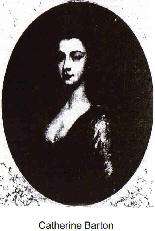Catherine Barton
| Catherine Barton Conduitt | |
|---|---|
 Catherine as a young woman | |
| Born |
Catherine Barton 1679 |
| Died | 1739 (aged 59–60) |
| Spouse(s) | John Conduitt |
| Relatives |
Robert Barton (father) Hannah Smith (mother) Isaac Newton (uncle) |
Catherine Barton (1679–1739) was Isaac Newton's half-niece, probable mistress of Charles Montagu and later, the wife of John Conduitt.
Early life
She was the second daughter of Robert Barton and his second wife, Hannah Smith, half-sister of Isaac Newton, and was baptized at Brigstock, Northampton on 25 November 1679.[1]
She was remarked upon by several men to be beautiful, witty and clever. Sometime after her uncle Newton moved to London to become Warden of the Mint in April 1696 she moved there to live with him.[2] She was known as a brilliant conversationalist, and attracted the admiration of such famous figures as Jonathan Swift and Voltaire.[3] Her uncle was also fond of her; an excerpt of an uncharacteristically warm letter from Newton survives, regarding her contraction of smallpox: "Pray let me know by your next how your face is and if your fevour be going. Perhaps warm milk from ye Cow may help to abate it. I am Your loving Unkle, Is. Newton."[4]
Voltaire insinuated that Newton's preferment to the Royal Mint was the result of her alleged affair with Charles Montagu. However, although it is true that Isaac was appointed under the patronage of Charles Montagu, it is clear that Catherine Barton came up to London and met Montagu after the appointment, not before.[5]
Relationship to Charles Montagu
Following the death of Charles Montagu's wife in 1698, Barton became his housekeeper and probably his mistress. There was much contemporary gossip on the subject, and thinly disguised accusations appeared in print. Delariviere Manley's Memoirs of 1710 featured a character called Bartica who was widely taken to represent Barton.
Montagu, by then Earl of Halifax, died of an inflammation of the lungs in May 1715.
His will contained two codicils: the first dated 12 April 1706, left the sum of £3000 and all his jewels to Barton; a second dated 1 February 1713 left her an additional £5000 plus his interest in the rangership of Bushey Park and his manor of Apscourt in Surrey to pay for the repairs to Bushey Lodge. On 30 August, however, he revoked the first codicil and begged his executor, his nephew George Montagu, not to make a dispute over her legacies. Montagu wrote that these bequests were "as a token of the sincere love, affection and esteem, I have long had for her person, and as a small recompense for the pleasure and happiness I have had in her conversation".[6]
Marriage
Barton then returned to live with her uncle at his home in St Martin's Street. On 9 July 1717 she became engaged to marry John Conduitt who had arrived in England a few weeks earlier in May of that year. On 23 August they were issued a licence to marry at St Paul's Covent Garden, but actually married three days later at St Martin in the Fields.[7] The couple had one daughter, Catherine, born in 1721.[8]
Later life
The couple lived at Cranbury Park, near Winchester; towards the end of his life, Newton took up residence at Cranbury with his niece and her husband, where he resided until his death in 1727.[9]
Conduitt died on 23 May 1737; she died in 1739 and was buried with her uncle and husband in Westminster Abbey.[10] Their only daughter and heir Catherine married John Wallop, Viscount Lymington, the eldest son of the first Earl of Portsmouth, and their son, John Wallop, succeeded as second Earl of Portsmouth.[11]
In fiction
A fictional Barton has a small role in Neal Stephenson's novel The System of the World, the final installment in Stephenson's Baroque Cycle.
She also has a role in Philip Kerr's novel Dark Matter: The Private Life of Sir Isaac Newton.
References
- ↑ Robert Barton's will, PROB11/416, National Archives; Parish register, Northampton Record Office.
- ↑ By her own account she was at his house when he received and solved Bernoulli's problem on 30 January 1697, King's College Cambridge, Keynes mss 129A & mss 130.5; Newton Correspondence Vol 4 p220.
- ↑ Swift, Journal to Stella, entries in 1710 and 1711.
- ↑ Newton Correspondence Vol 4, p349.
- ↑ Newton Correspondence, Vol 4, p195; & previous reference.
- ↑ Will proved in the Prerogative Court of Canterbury, PROB11/546, National Archives.
- ↑ Hants Record Office; Marriage Licences issued from the Faculty Office of the Archbishop of Canterbury at London, 1543–1869, Harl Soc vol 24, 1886.
- ↑ St Martin in the fields register, Westminster Record Office.
- ↑ Yonge, Charlotte M. (1898). "Cranbury and Brambridge". John Keble's Parishes – Chapter 6. www.online-literature.com. Retrieved 23 September 2009.
- ↑ Westminster Abbey registers, Harliean Society.
- ↑ The current one possesses the famous Isaac Newton portrait by Sir Godfrey Kneller, 1689.
Further reading
- Augustus De Morgan, Sophia Elizabeth De Morgan, Arthur Cowper Ranyard. Newton: his friend, and his niece. 1st ed (reprinted). London: Dawsons, 1968. 161 pp. isbn 0712903305.